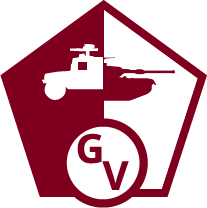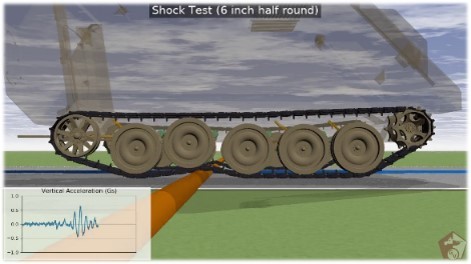


Simulation of the MRZR wheeled vehicle on a J-Turn Test (dynamic step steer rollover resistance maneuver)
CREATE-GV (Ground Vehicles)
The CREATE-GV project was recently established to develop physics-based, high performance computing (HPC) tools to enhance ground vehicle concept development, inform requirements development, and provide data for use in trade-space analysis, with an ultimate goal to positively impact cost, schedule, and performance and significantly reduce risk for the acquisition community. The project develops software tools for analyzing ground vehicle concept designs and mobility performance of wheeled and tracked ground vehicles, covering manned and unmanned vehicle applications. The software tools include Mercury and supplementary expansion tools that greatly enhance and extend the capabilities of Mercury. This combination of software enables virtual assessment of performance for proving ground and mission-level based mobility requirements. They are optimized for producing performance data for use in trade-space analysis, enabling consideration of numerous design trades early and often throughout the acquisition lifecycle.
 Mercury, the flagship CREATE-GV product, is a physics-based co-simulation
software tool for simulating proving-ground type developmental performance tests
used as acquisition requirements. Through its co-simulation framework, Mercury
integrates physics domains such as vehicle dynamics, powertrain, tire-soil and
track-soil interaction, and driver and control models. It can automatically
simulate multiple performance tests such as ride quality, discrete-obstacle shock,
soft-soil mobility, sand slope climbing, maximum speed, lane change stability,
and circular turn stability. Mercury utilizes detailed 3-dimensional vehicle
models that include component representations for suspension, driveline, powertrain,
steering systems, chassis, tires, tracks, and more.
Mercury, the flagship CREATE-GV product, is a physics-based co-simulation
software tool for simulating proving-ground type developmental performance tests
used as acquisition requirements. Through its co-simulation framework, Mercury
integrates physics domains such as vehicle dynamics, powertrain, tire-soil and
track-soil interaction, and driver and control models. It can automatically
simulate multiple performance tests such as ride quality, discrete-obstacle shock,
soft-soil mobility, sand slope climbing, maximum speed, lane change stability,
and circular turn stability. Mercury utilizes detailed 3-dimensional vehicle
models that include component representations for suspension, driveline, powertrain,
steering systems, chassis, tires, tracks, and more.
The Mercury expansion tools include the Mobility Analysis Tool (MAT) and the Ground Vehicle Interface (GVI). MAT is a model-based computational tool for predicting mission-level mobility performance metrics used as acquisition requirements. MAT can account for a wide variety of terrain, seasonal, and weather conditions to assess the suitability of vehicles for missions in multiple regions around the globe for differing terrain types and climatic zones. GVI is a web-based user interface providing a simplified, intuitive process to launch HPC simulations using Mercury and MAT, produce performance data required for robust trade-space analysis, and enable effective model data management and long-term knowledge reuse. GVI is accessible through the HPC Portal, which is available to HPCMP users via OpenID Connect login using CAC or YubiKey authentication from any internet access point.

Simulation of M113 tracked vehicle on a Shock Test (ride quality driving over discrete obstacles)
Requesting Access
To request access to any of the above software, please visit our Contact page.
